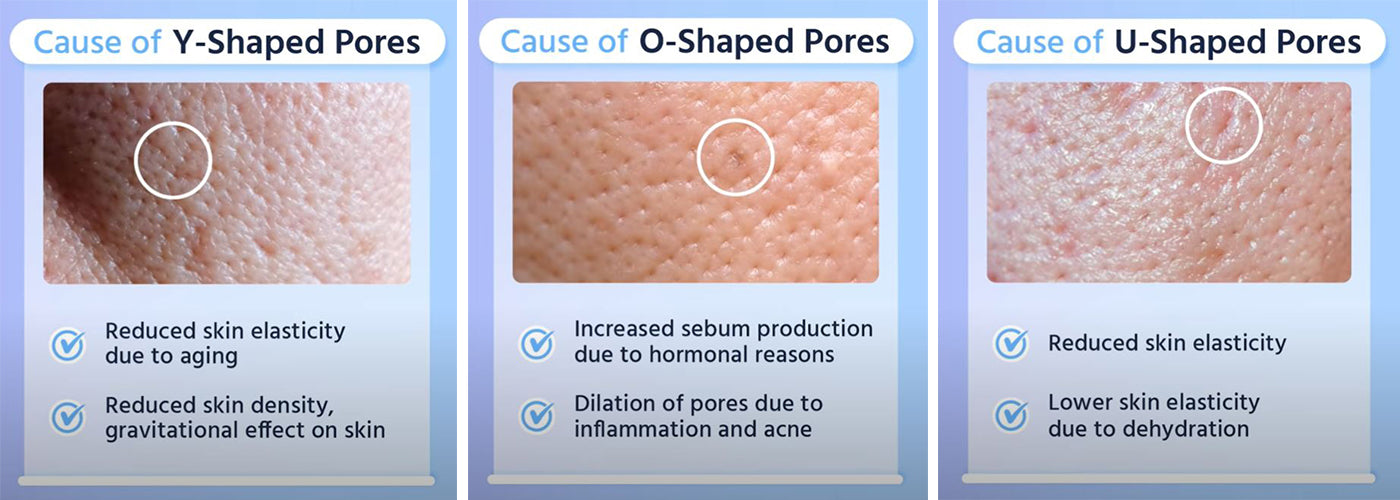3 Different Types of Pores and How to Treat Them Like a Pro
by Wendy Kim on Jul 31, 2020
What are pores?
Pores are tiny openings located along the surface of our skin. Openings that connect with the sebaceous glands and hair follicles. One of their main functions is to distribute the sebum along the dermis, which is ultimately what allows our skin to stay hydrated and resilient. Not only that, but they also allow the skin to breathe, get rid of toxins and regulate its temperature, which as you might be imagining is quite important as well.There are many different skin conditions and concerns that we have and experience. However, all of this comes down to one part of our skin, ‘pores’. We should always consider pores when it comes to skincare because what we choose to apply on the skin and how we decide to take care of our skin comes in contact with the pores and affects our skin in different layers. Today, let’s talk about ‘pores’ and let’s start from the basics.Do all pores look alike?
To answer the question first, 'no'. Anything from pore size to how visible pores are, varies among different individuals. Even the causes for enlarged pores vary among people according to their specific skin condition or skin types. However, pores can be categorized and diagnosed according to different shapes and according to where it is commonly found on the skin. Learn two different ways to give yourself a pores diagnosis and this will be a great start to learn how to treat your problematic pores and prevent further skin troubles.-
Different shapes of pores
 Learn detailed information on the different shapes of pores at Wishtrend TV
Learn detailed information on the different shapes of pores at Wishtrend TV
Pore Mapping
Pore mapping and acne face mapping are slightly different, since in this case, the focus is not on the external triggers but mostly on the specific qualities of the area, like for example the number of oil glands.The T-zone is one of the areas of the face in which oil glands are more abundant, which makes the T-zone the oilier part of the face. That is why your nose and forehead might be shining like a disco ball after every couple of hours because they are the part where everybody tends to get oily even if they have dry skin. Oilier skin is more prone to have big pores, so these areas tend to not only have large pores but also the biggest amount of blackheads and whiteheads.A. On the nose and chin
Are the most common kind of troublesome and visible pores, formed due to the high amount of sebaceous glands located on these areas of the face. Also due to their difficult access, removing whiteheads can get tricky. And if whiteheads are not removed they oxidize and turn into blackheads which are also more apparent and easily spotted.Focus on cleansing...
- - try combining cleansing oil with black sugar facial polish for effective pore cleansing with least skin irritation
- - try enzyme powder cleansers for exfoliation around the corners of the nose
- - try using the black sugar scrub as a nose pack by laving it on the nose for 10 minutes before a full cleansing routine
- - try volcanic face mask specifically around the nose areas
B. On the forehead
Besides the main reason of being an area with large amounts of sebaceous glands, pores on the face can appear bigger and get more easily clogged due to the usage of hair products. The areas on the forehead is larger than the nose areas and also can easily turn sensitive, thus should be taken care of with easy yet effective skincare ingredients.Focus on chemical exfoliants....
- - try LHA in a hydrating facial ampoule for topical use
- - try AHA in a hydrating facial toner for topical use
- - try green tea in the form of a enzyme powder wash for gentle exfoliating cleansing routine
C. On the cheeks
The cheeks along with the nose are where enlarge pores can be easily spotted. Enlarge pores around the cheeks are usually from poor cleansing habits, frequent contact with hands and pollutants and even due to long exposure to UV rays. Even taken care of and treated, because the cheeks are constanlty exposed to air and comes in contact with hands and face masks, it requires extra special care.Focus on a good oil-water balanced hydration...
- - try hydrating facial toners with the least viscosity for easy delivery of hydration
- - try adding sheet masks with gentle exfoliating ingredients to cover the large areas around the cheeks
- - try gel type creams with antioxdiants such as green tea for elasticity care












